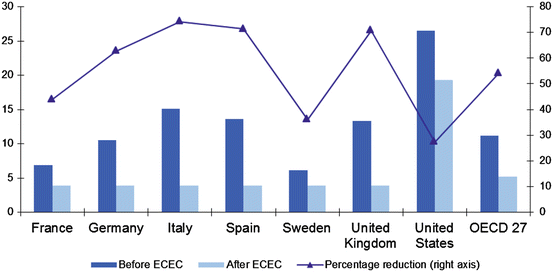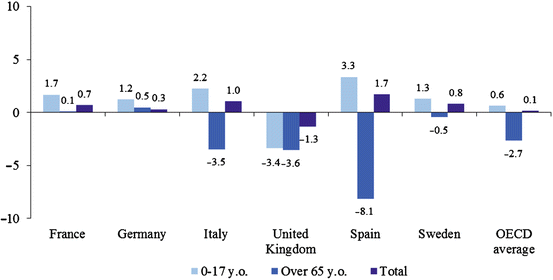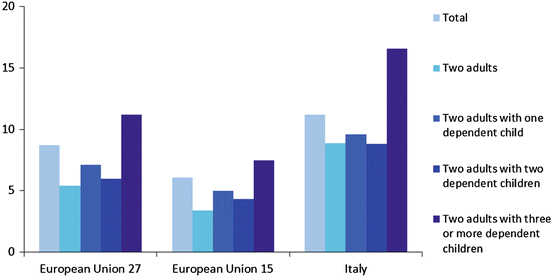Poverty and Social Exclusion of Children and Families in Italy and Europe: Some Comparisons

Fig. 11.1
Percentage point change in relative poverty rates (a) between 2007 and 2010 (b), 18–25 year olds and overall population (OECD 2013). Here are two notes, (a) and (b), which aim to clarify the previous text below Fig. 11.1.
Therefore:
note (a) illustrates what is meant by “relative poverty rates”
note (b) specifies the exact time periods considered for each country
The gloomy picture is confirmed by European-level data. The “Europe 2020” strategy of the European Union sets the goal of reducing the population at risk of poverty or social exclusion by at least 20 million people in the coming years. According to recent Eurostat data,4 in 2012 around one-fourth of European people were considered at risk of poverty or social exclusion (24.8 % in the EU-27 and EU-28 countries). In Italy almost one-third (29.9 %) of the population was estimated to be at risk of poverty or social exclusion, more than 5 percentage points above the European average. Europe identifies three specific indicators of “poverty or social exclusion”: people at risk of poverty, people who are suffering from severe material deprivation, people living in households with very low work intensity.5
11.2 The Impact of Public Policies
As mentioned above, public policies based on taxes and social transfers mitigated the marked increase in overall income inequality between 2007 and 2010 in OECD countries. However, the impact of taxes and transfers differed among different population groups. The crisis has particularly affected families with children. Between 2007 and 2010, poverty among children and young people increased in a large number of OECD countries. Notably, on average across OECD countries, the rates of relative poverty increased among children (by 0.6 percentage points) and moderately decreased among the elderly (by 2.7 percentage points), against a general stability (slight increase of 0.1 percentage points) in the overall population. Italy underwent the same trends, although on a larger scale: the incidence of relative poverty increased significantly among children (by 2.2 percentage points) while it decreased among the elderly (by 3.5 percentage points), compared to an overall increase by 1 percentage point in the overall population (Fig. 11.2).


Fig. 11.2
Percentage point change in relative poverty rates (a) between 2007 and 2010 (b), by age groups (OECD 2013). Here are two notes, (a) and (b), which aim to clarify the previous text below Fig. 11.2.
Therefore:
note (a) illustrates what is meant by “relative poverty rates”
note (b) specifies the exact time periods considered for each country
11.3 Poverty of Children and Families
In comparison to Europe, Italy has a critical position in terms of exposure to the risk of poverty for children and families. According to Eurostat data,6 the rate of severe material deprivation across the overall population in Italy in 2011 (11.2 %) was higher than the average of the “old” EU-15 (6.1 %), but also compared to the average of the EU-27 (8.7 %). Considering families with a couple of adults, the Italian rate was systematically higher than the European average, peaking at 16.6 % among families with two adults and three or more children, against 7.5 % in the EU-15 and 11.2 % in the EU-27 (Fig. 11.3).


Fig. 11.3
Rate of severe material deprivation, by family type, 2011 (Eurostat, Income and living conditions)
Overall, risk of poverty or social exclusion increases with the number of children. Rates are systematically higher in Italy than on average in Europe: the percentage of people at risk of poverty or social exclusion in 2011 was 22.9 % among adult couples without children (compared to 16.9 % and 18.4 % on average in the EU-15 and in the EU-27), 24 % among couples with a child (compared with 17.1 % and 18.5 %, respectively), 27.1 % among couples with two children (compared to 17.9 % and 19.3 % respectively), up to 42 % among couples with three or more children (compared with 27.4 % and 30.8 %, respectively).
Eurostat data confirm that children are particularly at risk of poverty or social exclusion. At the European level, the average percentage of people at risk of poverty or social exclusion in 2011 was higher among children less than 6 years old (24 % in the EU-15 and 25.4 % in the EU-27, rising to 24.7 % and 25.9 % respectively in 2012) than among the overall population (22.6 % in the EU-15 and 24.3 % in the EU-27, rising to 23.2 % and 24.8 % respectively in 2012). In Italy the risk of poverty or social exclusion for children up to 6 years (28.9 % in 2011, rising to 31.9 % in 2012) is significantly higher than both the corresponding EU average and the rate among the overall Italian population (28.2 %, rising to 29.9 % in 2012). The national picture is therefore particularly worrying. The percentage of people at risk of poverty or social exclusion in the overall population in Italy was the 7th highest in the EU-27 (after Bulgaria, Romania, Latvia, Lithuania, Hungary and Greece) in 2011, whereas the percentage among children younger than 6 years old was the 5th highest (after Bulgaria, Romania, Latvia and Hungary).
The incidence of poverty risk in 2011 was also significantly higher among children less than 6 years old (18.9 % in the EU-15 and 19.2 % in the EU-27) compared to the overall population (16.7 % in the EU-15 and 16.9 % in the EU-27). Italy is characterized by a significantly higher incidence of poverty risk in early childhood (24.5 % in 2011) both in comparison to the European average and in comparison to the rate among the overall Italian population (19.6 %). In an ideal European ranking (EU-27) of the at-risk-of-poverty rate in 2011, Italy ranked 6th considering the overall population (after Bulgaria, Romania, Spain, Greece and Lithuania), but 3rd (after Romania and Bulgaria) considering the age group of children up to 6 years.
Early childhood is also particularly exposed to the risk of severe material deprivation. At the EU level in 2011 the risk of severe material deprivation was higher among children younger than 6 years (7.3 % in the EU-15 and 9.6 % in the EU-27) compared to the overall population (6.1 % in the EU-15 and 8.7 % in the EU-27). In comparison with Europe, Italy is characterized by a higher risk, affecting 11.5 % of Italian children younger than 6 years in 2011 (compared to 11.2 % of the overall Italian population). In 2011 Italy exhibited the 8th highest rate of severe material deprivation among total population at the European level (after Bulgaria, Latvia, Romania, Hungary, Lithuania, Greece and Poland), and the 9th highest rate among children less than 6 years old (after all countries listed above, plus Slovakia).
Across the EU-27 countries, Italy therefore ranks among the top positions as regards the risk of poverty, social exclusion and material deprivation, and these effects are particularly pronounced for children less than 6 years old.
The situation is even more serious considering only the “old” EU-15: within this group of countries, in 2011 Italy exhibited the highest percentage of children 0–6 years old at risk of poverty, at risk of poverty or social exclusion, at risk of housing deprivation; and the second highest percentage (after Greece) with respect to the rate of severe material deprivation in early childhood.